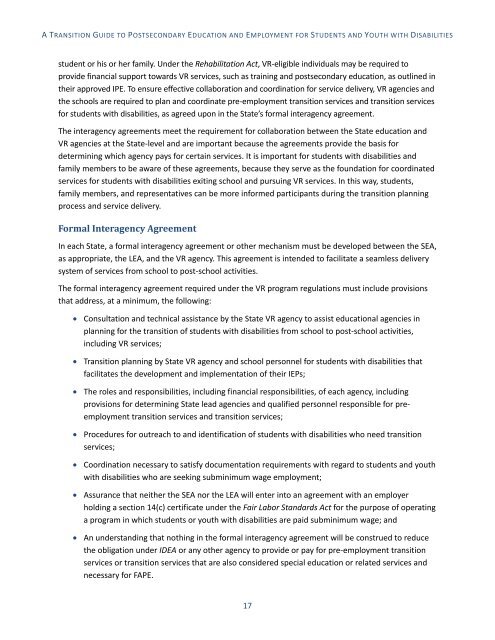TRANSITION GUIDE
2j9tM4H
2j9tM4H
Create successful ePaper yourself
Turn your PDF publications into a flip-book with our unique Google optimized e-Paper software.
A <strong>TRANSITION</strong> <strong>GUIDE</strong> TO POSTSECONDARY EDUCATION AND EMPLOYMENT FOR STUDENTS AND YOUTH WITH DISABILITIES<br />
student or his or her family. Under the Rehabilitation Act, VR-eligible individuals may be required to<br />
provide financial support towards VR services, such as training and postsecondary education, as outlined in<br />
their approved IPE. To ensure effective collaboration and coordination for service delivery, VR agencies and<br />
the schools are required to plan and coordinate pre-employment transition services and transition services<br />
for students with disabilities, as agreed upon in the State’s formal interagency agreement.<br />
The interagency agreements meet the requirement for collaboration between the State education and<br />
VR agencies at the State-level and are important because the agreements provide the basis for<br />
determining which agency pays for certain services. It is important for students with disabilities and<br />
family members to be aware of these agreements, because they serve as the foundation for coordinated<br />
services for students with disabilities exiting school and pursuing VR services. In this way, students,<br />
family members, and representatives can be more informed participants during the transition planning<br />
process and service delivery.<br />
Formal Interagency Agreement<br />
In each State, a formal interagency agreement or other mechanism must be developed between the SEA,<br />
as appropriate, the LEA, and the VR agency. This agreement is intended to facilitate a seamless delivery<br />
system of services from school to post-school activities.<br />
The formal interagency agreement required under the VR program regulations must include provisions<br />
that address, at a minimum, the following:<br />
• Consultation and technical assistance by the State VR agency to assist educational agencies in<br />
planning for the transition of students with disabilities from school to post-school activities,<br />
including VR services;<br />
• Transition planning by State VR agency and school personnel for students with disabilities that<br />
facilitates the development and implementation of their IEPs;<br />
• The roles and responsibilities, including financial responsibilities, of each agency, including<br />
provisions for determining State lead agencies and qualified personnel responsible for preemployment<br />
transition services and transition services;<br />
• Procedures for outreach to and identification of students with disabilities who need transition<br />
services;<br />
• Coordination necessary to satisfy documentation requirements with regard to students and youth<br />
with disabilities who are seeking subminimum wage employment;<br />
• Assurance that neither the SEA nor the LEA will enter into an agreement with an employer<br />
holding a section 14(c) certificate under the Fair Labor Standards Act for the purpose of operating<br />
a program in which students or youth with disabilities are paid subminimum wage; and<br />
• An understanding that nothing in the formal interagency agreement will be construed to reduce<br />
the obligation under IDEA or any other agency to provide or pay for pre-employment transition<br />
services or transition services that are also considered special education or related services and<br />
necessary for FAPE.<br />
17


